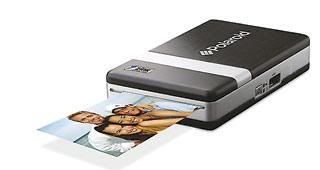
Millions of families have enjoyed instant pictures along with the emergence type Polaroid photographs, an alternative to the traditional method involving periods of up to a week for developarea and printing pictures, writes New York Times.
Now, however, Polaroid wants to associate that period with the new technology of digital pictures made with the new mobile phone or digital cameras.
This fall, the company wants to market the size of a printer capable of very small print photos on a digital format in about 30 seconds.
The printer that uses wireless devices like Bluetooth to ensure connection with mobile phones and digital appliances, will cost around 150 dollars (94.91 euros) and size pictures will be 5.08 to 7.62 centimeters, the size of a credit card.
The printer uses a system similar laptopurilor opening and instead of toner uses a chip and a new type of paper printed with layers of microscopic crystals. Crystals can create a multitude of colors when they are warm.
The printer turn signal received from the camera or phone in information on the intensity of heat required picture.
This new type of paper is the creation of former Polaroid employees have created a new company, Zink Imaging, when Polaroid bankruptcy and takeover by Petters Group Worldwide. The printer will be produced by Alps Electric Company of Tokyo.
A potential market for such a product is huge and largely neexplorat, said Steve Hoffenberg, analyst at Lyra Reaserch, business market research. “Today, the large number of mobile phones able to make pictures and digital devices caused a substantial increase pictures made by the great mass of ordinary users,” added May.
Lyra estimates of marketing 880 million phones with photo camera for the year 2008.
However it could be difficult for her new printers create a niche market. According to estimates the same companies, approximately 478 billion photos will be made in 2008, mostly using mobile phone, but only a small part will be printed. The argument consists in the fact that most prefer to post these pictures on web pages or send them to friends via e-mail.
The target group for this new type of printer could be young teenagers or even professional groups such as real estate agents.
Browse will cost less than traditional Polaroid pictures as in the past ten years had prices of at least one U.S. dollars (63 eurocenti), said Jim Alviani, director of business development at Polaroid.
Hartia people from Zink will sell in packets of ten units for the price of 3.99 dollars (2.52 euros) or 30 for 9.99 U.S. dollars (6.32 euros).
The source of energy used by the printer will be a lithium-ion battery, with a term of life enough to print some 15 photos.
Printers can be attached anywhere because of an adhesive layer.
According to Steve Herchen, director of the department of technological Zink, the new paper will be used for other brands in the future not only for Polaroid.
Tomy Company of Tokyo plans to incorporate such a printer in a gallery room, he said. The company responsible for creating these rooms will be Foxconn Technology Group of Taiwan.
Hartia Zink is similar to ordinary photographic paper, the difference in composition, which uses a layer of plastic and other layers of overlapping crystals in succession, added Herschen.
Each photograph printed will contain approximately 100 billion of such crystals. During the printing process of forming crystals are so warm colors.
On the other hand, according to Hoffenberg’s declarations, no matter how ingenious process might be, many would not be tempted to print photos taken by mobile phone.